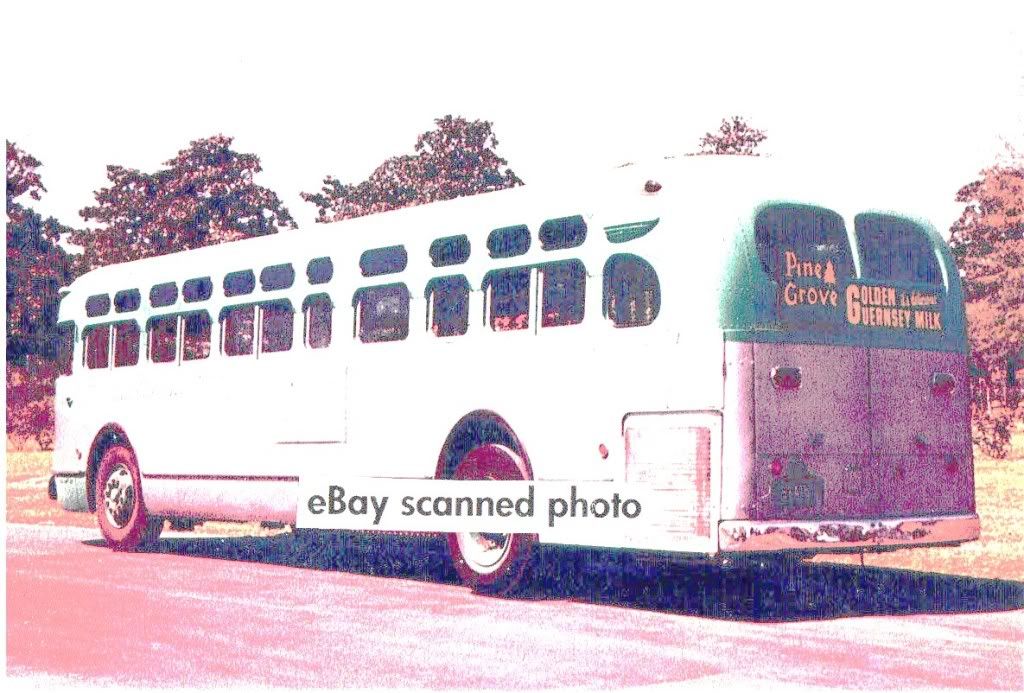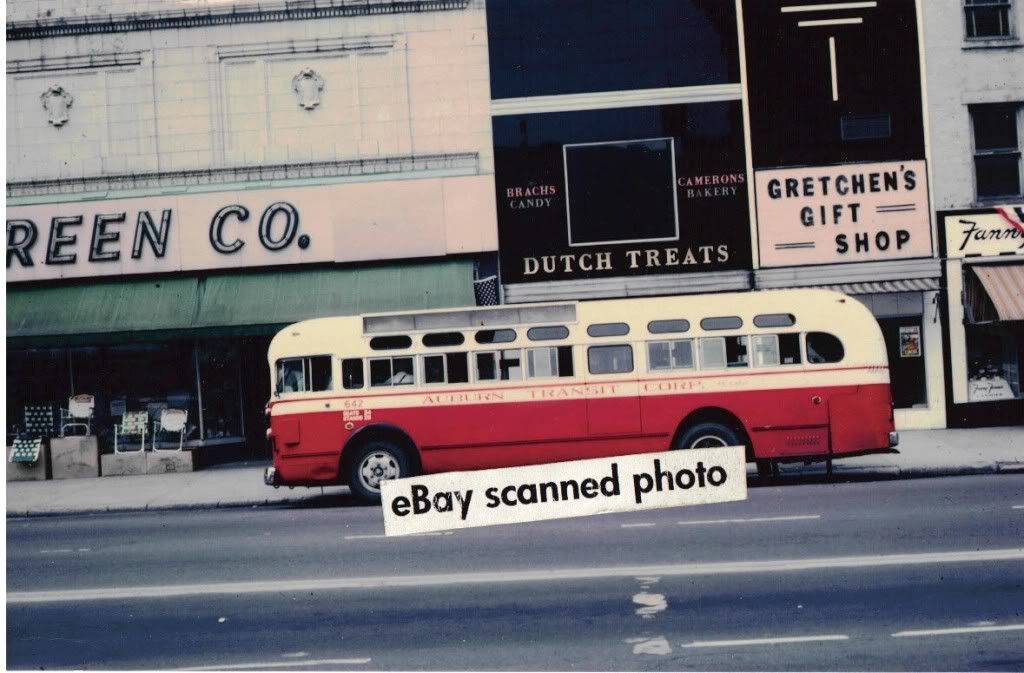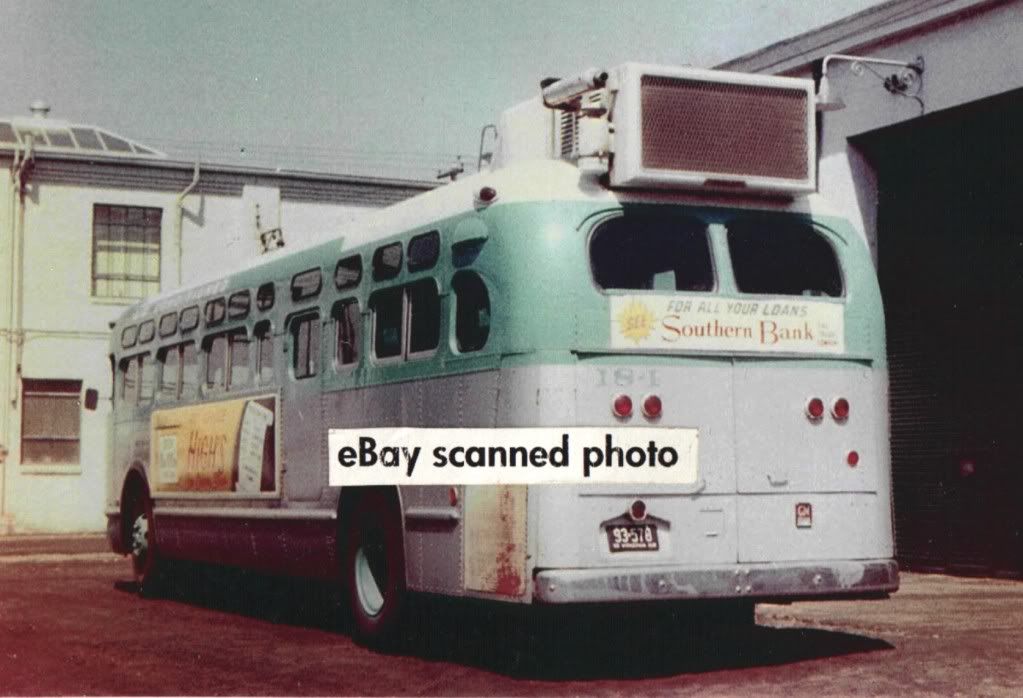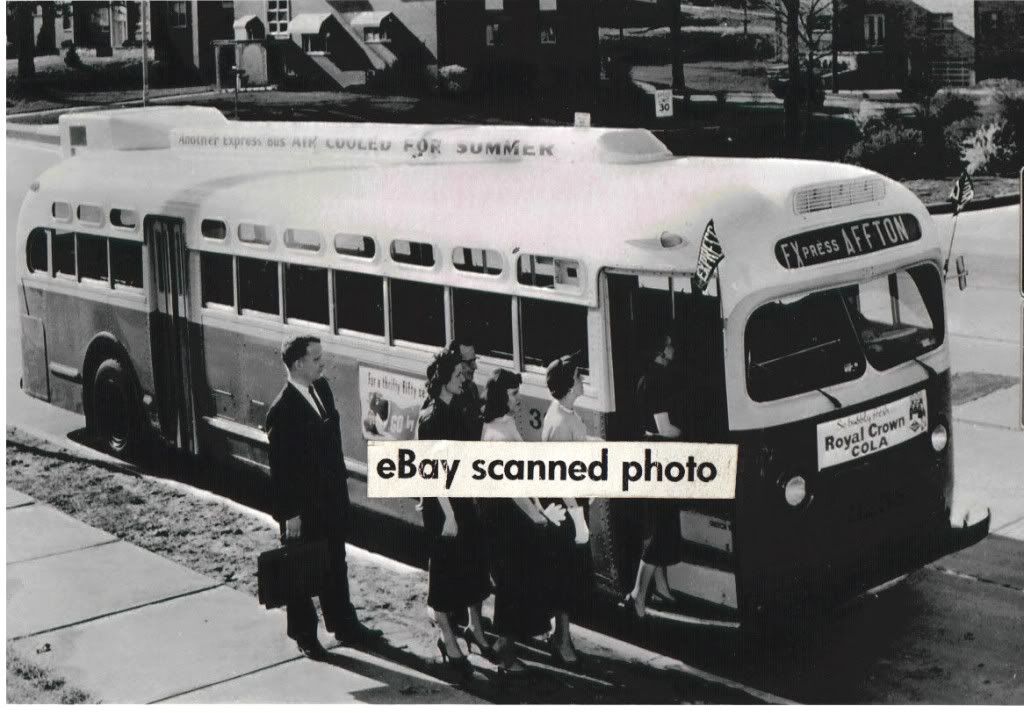 |
BusTalk
A Community Discussing Buses and Bus Operations Worldwide!
|
| View previous topic :: View next topic |
| Author |
Message |
JimmiB
Age: 81
Joined: 19 Apr 2011
Posts: 516
Location: Lebanon, PA
|
 Posted: Fri Mar 02, 2012 11:43 pm Post subject: Posted: Fri Mar 02, 2012 11:43 pm Post subject: |
 |
|
Mr.L,
Your comments on the Golden Glow headlights just reminded me of another oddity. Some of the older buses I drove for Reading Bus had a toggle switch on the dash to choose between "city and country" lights. The country light setting was normal high and low beams. The city setting gave you low beam and a lower "glow" light. I believe these were on the Yellow Coach 4007's that were delivered in 1944 and 1946. Would have been fleet numbers 701-717. |
|
| Back to top |
|
 |
Mr. Linsky
BusTalk's Offical Welcoming Committee

Joined: 16 Apr 2007
Posts: 5071
Location: BRENTWOOD, CA. - WOODMERE, N.Y.
|
 Posted: Sat Mar 24, 2012 2:01 am Post subject: Posted: Sat Mar 24, 2012 2:01 am Post subject: |
 |
|
We often talk about the fact that we see so few shots of the rear ends of buses which, in my estimation, can be as important as frontal views.
Photographed in Norfolk, Virginia in April of 1952, we glimpse just such a view of fleet # 915 - a 1951 GM Coach Model TDH 4509 and one of twenty likenesses numbered from 901 to 920 operating for the Virginia Transit Company (VTC) of Norfolk, Virginia.
# 915 is a phase II 4509 as evidenced by the roof reinforcement which reduced the width of the single passenger windows forward of the rear and emergency doors.
The phase II project did not update the fresh air intake cowls over the rear lounge seat quarter windows nor was a GM badge added to the lower right engine panel - those changes took place in phase III.
Of note on # 915 is the optional large and very bright directional signal fixtures that were used on most post war ACF equipment and a far cry from the tiny and useless arrows GM supplied as standard at the time.
For you newbie GM Old Look bus spotters here's a hint on judging the widths of the different models; on the 102 inch wide 4510's, 4511's, 5103's and 5105's there is a marked separation between the two rear windows measuring over seven inches while on the 96 inch wide jobs (which were all others) that separation measured at about an inch and a half.
Photo courtesy of 4509bus and is up for bid on eBay as item # 350550781863.
Mr. Linsky - Green Bus Lines, Inc., Jamaica, New York
 |
|
| Back to top |
|
 |
frankie
Age: 77
Joined: 01 Feb 2011
Posts: 747
Location: St. Peters, Mo.
|
 Posted: Sat Mar 24, 2012 9:03 pm Post subject: Posted: Sat Mar 24, 2012 9:03 pm Post subject: |
 |
|
| Mr. Linsky wrote: |
For you newbie GM Old Look bus spotters here's a hint on judging the widths of the different models; on the 102 inch wide 4510's, 4511's, 5103's and 5105's there is a marked separation between the two rear windows measuring over seven inches while on the 96 inch wide jobs (which were all others) that separation measured at about an inch and a half.
|
To illustrate what Mr. L. is saying, I thought I'd take a different approach and show the difference from the interior. The comparison shots also shows how much aisle room an extra 6 inches can make.
Frankie
Photo courtesy of James Clifford Greller for educational purposes only.

 |
|
| Back to top |
|
 |
traildriver
Joined: 26 Mar 2011
Posts: 2459
Location: South Florida
|
 Posted: Sat Mar 24, 2012 10:46 pm Post subject: Posted: Sat Mar 24, 2012 10:46 pm Post subject: |
 |
|
| frankie wrote: | | Mr. Linsky wrote: |
For you newbie GM Old Look bus spotters here's a hint on judging the widths of the different models; on the 102 inch wide 4510's, 4511's, 5103's and 5105's there is a marked separation between the two rear windows measuring over seven inches while on the 96 inch wide jobs (which were all others) that separation measured at about an inch and a half.
|
To illustrate what Mr. L. is saying, I thought I'd take a different approach and show the difference from the interior. The comparison shots also shows how much aisle room an extra 6 inches can make.
Frankie
Photo courtesy of James Clifford Greller for educational purposes only.

 |
Indeed it did. When I used to ride these on the way to school, often six of us would sit across that rear bench...... |
|
| Back to top |
|
 |
Mr. Linsky
BusTalk's Offical Welcoming Committee

Joined: 16 Apr 2007
Posts: 5071
Location: BRENTWOOD, CA. - WOODMERE, N.Y.
|
 Posted: Sat Mar 24, 2012 11:50 pm Post subject: Posted: Sat Mar 24, 2012 11:50 pm Post subject: |
 |
|
Quoting Traildriver; Indeed it did. When I used to ride these on the way to school, often six of us would sit across that rear bench......
There's nothing wrong with what Traildriver said - in fact, I have always described the rear seat over the engine and between the two quarter windows as being a bench.
However, in Yellow's first 'Old Look' catalog dated in early 1940 it describes that seat as a 'five passenger lounge seat'. (seen on page 122 of Luke's Yellow Coach Buses 1923/1943).
I thought that to be a more classy description so I use it myself now but, beyond that, I don't have to tell you how many drivers lounged on those seats at layovers in dark and desolate spots and what they did - I'll let your imagination take care of that one!
And, the answer is no! I never let my girlfriends ride with me!
Regards,
Mr. 'L' |
|
| Back to top |
|
 |
frankie
Age: 77
Joined: 01 Feb 2011
Posts: 747
Location: St. Peters, Mo.
|
 Posted: Sun Mar 25, 2012 12:38 am Post subject: Posted: Sun Mar 25, 2012 12:38 am Post subject: |
 |
|
My fond memories of the "lounge seat" was when I was a young kid living in Brooklyn back in the '50's. Often when Mom went on her shopping trips to Fulton St. in downtown Brooklyn, we either took the 26 Putnam, 52 Gates or 38 DeKalb bus to Fulton St. (Civic Center destination). All three routes were served by the TDH-4510 and my favorite spot was the center of that seat. Often the buses were empty. Sitting by the engine always made the trip that much more enjoyable.
I was to that seat as Edith Ann was to her rocker and Gallagher to his giant couch! As skinny as I was back then, that seat could have fitted 7 of me!
Frankie |
|
| Back to top |
|
 |
fishbowl

Age: 76
Joined: 01 Sep 2010
Posts: 62
Location: Detroit
|
 Posted: Tue Mar 27, 2012 6:22 pm Post subject: Posted: Tue Mar 27, 2012 6:22 pm Post subject: |
 |
|
| Mr. Linsky wrote: | | I don't have to tell you how many drivers lounged on those seats at layovers in dark and desolate spots and what they did - I'll let your imagination take care of that one! |
Speaking of memories and lounge seats...
Back in my CTA (Chicago) days as a driver, a normal "run" consisted of two halves, with lunch in between. After about four hours, another driver would "relieve" me somewhere along with route (usually at a major intersection), and an hour later I would "relieve" someone else, and finish the final four-or-so hours of my run.
Except overnight, when there were far fewer buses on the street. On "owl" runs, as they were called, the scheduling was such that, after four hours, you simply sat with your bus at a terminus, ate lunch, and got back on the road an hour later.
But at 3AM, the temptation (for me, anyway) was to eat quick and catch a few z's... on the lounge seat, of course. Unfortunately, it's hard to know while sleeping comfortably and soundly on a lounge seat when an hour is up. So - you guessed it - one night at the Archer & Harlem turnaround in Chicago, I woke up about 45 minutes late. I phoned in, expecting to be fired, or, at the least, disciplined, but instead was told by a sympathetic dispatcher just to "get going" and, with a little hustle, I would make up the 45 minutes by the time I hit downtown. To my amazement, I did.
I learned three lessons about bus driving that night: 1) While on the job, stay awake at all costs (or bring along an alarm clock). 2) There's a lot of coasting (sight seeing?) time built in to owl runs (at least in Chicago). 3) At night, it's always a good idea to leave a terminus late. This makes it unnecessary to intentionally lose red lights along the way (passengers know when a driver is doing that, and they hate it!), and it helps avoid running "hot" in the middle of the night and being written up by a supervisor lurking in the dark. Gotcha! |
|
| Back to top |
|
 |
JimmiB
Age: 81
Joined: 19 Apr 2011
Posts: 516
Location: Lebanon, PA
|
 Posted: Tue Mar 27, 2012 11:44 pm Post subject: Posted: Tue Mar 27, 2012 11:44 pm Post subject: |
 |
|
| Lots of memories on the "lounge seats", but nothing I can talk about on the forum. |
|
| Back to top |
|
 |
frankie
Age: 77
Joined: 01 Feb 2011
Posts: 747
Location: St. Peters, Mo.
|
 Posted: Wed Mar 28, 2012 12:04 pm Post subject: Posted: Wed Mar 28, 2012 12:04 pm Post subject: |
 |
|
| Mr. Linsky wrote: |
# 915 is a phase II 4509 as evidenced by the roof reinforcement which reduced the width of the single passenger windows forward of the rear and emergency doors.
The phase II project did not update the fresh air intake cowls over the rear lounge seat quarter windows nor was a GM badge added to the lower right engine panel - those changes took place in phase III.
|
I never knew there were phases when it came to the old look. I assume that Mr. L. is referring only to the 35 foot TDH-4509/12 models.
I know that the new looks had a time line of four generations and all had exterior features to distinguish one from the other. With a very few exceptions, there were no options available for ordering new looks that would deviate physical features from the standard - such as different taillights for examples. Whereas on old looks these standards were almost non existence which is why there are various types of tail lights (design & position), front signals lights, below windshield trim treatment, etc. Is what Mr. L listed that changed one phase to the other on the old look the "standard" that was present on all buses during that phase?
The "GM New Look Bus" by McKane & Squire is a great study of the new look and very uncomplicated as far as distinguishing the difference in generations - so much so that its easy to identify any particular model just by those physical differences. I would love to see a book on the old look similar in scope to the Mckane/Squire book, but an in depth study would be very complicated and an almost impossible endeavor for anyone willing to take on that task - even if only restricted to the paired windows generation of buses.
Frankie |
|
| Back to top |
|
 |
Mr. Linsky
BusTalk's Offical Welcoming Committee

Joined: 16 Apr 2007
Posts: 5071
Location: BRENTWOOD, CA. - WOODMERE, N.Y.
|
 Posted: Wed Mar 28, 2012 3:08 pm Post subject: Posted: Wed Mar 28, 2012 3:08 pm Post subject: |
 |
|
frankie,
Of all the Old Looks, the 4509 was subjected to more modifications than any other model and in the last of the upgrades the buses appeared outwardly to be exactly like the 4512's - no expert could tell them apart.
You can see two excellent examples in Luke's 'Old Look Buses - Yellow & GM 40's & 50's with the first being on page 31 - Pittsburgh # 235 purchased in January 53 and on page 79 (bottom) Crown Coach Company # 183 purchased in February 53 and both being among the last 4509's ever to be produced.
Of note are the signals lights, 'plastic' GM badges and the fresh air cowls over the rear quarter windows without the 'Deco' bars under them.
Regards,
Mr. 'L' |
|
| Back to top |
|
 |
Mr. Linsky
BusTalk's Offical Welcoming Committee

Joined: 16 Apr 2007
Posts: 5071
Location: BRENTWOOD, CA. - WOODMERE, N.Y.
|
 Posted: Sat May 12, 2012 1:52 am Post subject: Posted: Sat May 12, 2012 1:52 am Post subject: |
 |
|
Seen in downtown Auburn, New York in July of 1967 is fleet # 642 - a 1964 GM Model TDH 3501 and one of two likenesses with the other numbered 641 delivered to BEQ Leasing, Inc. of Utica, New York for the Auburn Transit Corporation.
The oddity here are the sliding passenger windows which are so rare on a squared window GM Old Look transit that I'm doubtful that they were of GM origin.
Also of interest is the device over the first four standee glasses that could be a modified version of the 'Bat Wing' ad sign concept used on later New Look models although it doesn't seem deep enough to be back lit.
Photo courtesy of 4509Bus and is up for bid on eBay as item# 370611881973.
Mr. Linsky - Green Bus Lines, Inc., Jamaica, New York
 |
|
| Back to top |
|
 |
roymanning2000
Age: 75
Joined: 01 Aug 2007
Posts: 198
|
 Posted: Mon May 14, 2012 8:25 am Post subject: Posted: Mon May 14, 2012 8:25 am Post subject: |
 |
|
The sliding windows were a GM option. I've seen photos of 3501's owned by other operators that had the sliders also. One that comes to mind is a subsidiary of Suburban Transit in New Jersey.
Roy |
|
| Back to top |
|
 |
Mr. Linsky
BusTalk's Offical Welcoming Committee

Joined: 16 Apr 2007
Posts: 5071
Location: BRENTWOOD, CA. - WOODMERE, N.Y.
|
 Posted: Sat May 19, 2012 1:14 am Post subject: Posted: Sat May 19, 2012 1:14 am Post subject: |
 |
|
From the GM Old Look oddity file comes fleet number 184 - a 1959 GM Coach Model TDH 4512 and one of fifteen likenesses numbered from 181 to 195 operating for the Richmond Division of the Virginia Transit Company (VTC).
In the last years of heavy duty GM Old Look production it wasn't unusual to see either GM fabricated or after market air conditioners with condenser coil, and fan cabinets along with duct work on the rear of the roof with compressors either driven by the main engine or a gasoline unit under floor.
However, some operators such as VTC were known to experiment and fleet # 184 below was no exception with a completely self contained unit on its roof.
Of particular note are the engine exhaust muffler and size and weight of the apparatus which must have played havoc with the rear air suspension!
The manufacturer's name is not clear but may well have been either Frigidaire or ThermoKing with both of which being major suppliers especially to the trucking industry.
The photo, taken in Richmond in April of 1962, is courtesy of 4509bus and is up for bid on eBay as item # 370614960686.
Mr. Linsky - Green Bus Lines, Inc., Jamaica, New York
 |
|
| Back to top |
|
 |
Mr. Linsky
BusTalk's Offical Welcoming Committee

Joined: 16 Apr 2007
Posts: 5071
Location: BRENTWOOD, CA. - WOODMERE, N.Y.
|
 Posted: Sun May 20, 2012 3:10 am Post subject: Posted: Sun May 20, 2012 3:10 am Post subject: |
 |
|
While we're on the subject of retrofitting GM Old Look buses with Air Conditioning, let's look at the 'granddaddy' of the art as we see fleet # 3255 - a 1947 GM Coach Model TDH 4507 and one of one hundred numbered from 3200 to 3299 delivered to St. Louis Public Service of St. Louis, Missouri in June of that year.
While I am unsure of just how many of this one hundred bus order were eventually air conditioned, it's certain that those designated for special Express routes were as evidenced by both the destination sign and the boast of the feature written on the roof.
I'm told that St. Louis was so good at the retrofits that they contracted themselves out to other operators far and wide to make these special installations.
Of note is the extra fuel filler nearer to the rear door which, in this case, fed an under floor gasoline engine and compressor.
It must have been refreshing to step into an air conditioned 4507 - I never had such luck in my three summers behind the wheel with Green Line (NY)!
Photo, taken in St. Louis in 1956, courtesy of 4509bus and is up for bid on eBay as item # 350567181501.
Mr. Linsky - Green Bus Lines, Inc., Jamaica, New York
 |
|
| Back to top |
|
 |
frankie
Age: 77
Joined: 01 Feb 2011
Posts: 747
Location: St. Peters, Mo.
|
 Posted: Sun May 20, 2012 10:04 am Post subject: Posted: Sun May 20, 2012 10:04 am Post subject: |
 |
|
| Mr. Linsky wrote: | ......and one of one hundred numbered from 3200 to 3299 delivered to St. Louis Public Service of St. Louis, Missouri in June of that year.
While I am unsure of just how many of this one hundred bus order were eventually air conditioned, it's certain that those designated for special Express routes were as evidenced by both the destination sign and the boast of the feature written on the roof.
Mr. Linsky - Green Bus Lines, Inc., Jamaica, New York
|
When I arrived in the summer of '69 to start my career in St. Louis, every old look bus was air-conditioned regardless whether it was local or express. St. Louis summers can be brutal with 90+ and high humidity for long stretches and these buses were a welcome relief to the general riding public. One can always hear the little gas engines just cranking away especially when a bus is idle at at stop light or picking up passengers.
Frankie |
|
| Back to top |
|
 |
|
|
You cannot post new topics in this forum
You cannot reply to topics in this forum
You cannot edit your posts in this forum
You cannot delete your posts in this forum
You cannot vote in polls in this forum
You can attach files in this forum
You can download files in this forum
|
Powered by phpBB © 2001, 2005 phpBB Group
|








